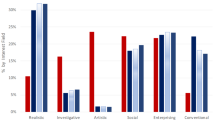Abstract
This study updates the data on the numbers and the changing origins of immigrants into the U.S. with technical qualifications and ability, and the economic gain to the U.S. therefrom. It also provides new data on the quality of such personnel by examining the number of immigrants who are elected to the U.S. National Academies of Engineering and of Science, and also win Nobel prizes. It is shown that this immigration is a major continuing contribution to the U.S.; constituting substantial fractions (one third to one-half) of certain categories of advanced degrees. Using different methods of calculating the value of the education thus transfered one arrives at the general conclusion that it is roughly in balance with the total economic aid from the U.S. (i.e. in the order of several billion slyear in the last two decades). Immigrant engineers/scientists constitute about a fifth of National Academy membership and between 20 and 50% of the Nobel prize winners, depending on the discipline involved, with chemistry appearing as the native national strength of the U.S.
Similar content being viewed by others

References
U. S. House of Representatives, Committee on Education and Labor, Hearings on Mathematics and Science Education, Washington, Feb. 1983.
H. G. GRUBEL, The Brain Drain: A U.S. Dilemma,Science, 54 (1966) 1420–1424.
H. G. JOHNSON, The Economics of the “Brain Drain”: The Canadian Case,Minerva, 3 (1965) 299–301.
J. A. PERKINS, Foreign Aid and the Brain Drain,Foreign Affairs, 44 (1966) 608–619.
J. C. SHEARER, In Defence of Traditional Views on the “Brain Drain” Problem,International Educational and Cultural Exchange, (1966) 17–25.
U.S. House of Representatives Committee on Government Operations, Research and Technical Programs Subcommittee, The Brain Drain into the United States of Scientists, Engineers and Physicians, Washington, 1979.
U.S. House of Representatives Committee on Foreign Affairs, Subcommittee on National Security Policy and Scientific Developments, Brain Drain: A Case Study of the Persistent Issue of Scientific Mobility, Washington, 1974.
United Nations Conference on Trade and Development, The Reverse Transfer of Technology, United Nations, New York, 1975.
W. A. GLASER,The Brain Drain: Emigration and Return, Pergamon Press, New York, 1978.
B. A. GUHA, Brain Drain Issues and Indicators on Brain Drain,International Migration, 15 (1977) 3–20.
J. N. BHAGURATI, M. PARTINGTON, Eds,Taxing the Brain Drain, North Holland Company, Amsterdam, 1976.
H. G. GRUBEL, A. SCOTT,The Brain Drain, Wilfrid Laurier, Waterloo, Canada, 1977.
U.S. National Science Foundation, Foreign Participation in U.S. Science and Engineering Higher Education and Labor Markets, National Science Foundation, Washington, 1981, pp. 16–17; and National Research Council, Summary Report, 1980: Doctorate Recipients from United States Universities, National Academy Press, Washington, 1981, p. 19.
National Research Council, pp. 10–13; and U.S. National Science Foundation, Immigrant Scientists and Engineers in the U.S., National Science Foundation, Washington, 1973,passim.
Ronald SULLIVAN, Coping with Curbs on Foreign Doctors,New York Times, July 6, 1980, IV, 9.
H. G. GRUBEL, A. SCOTT, pp. 71–75.
United Nations Conference on Trade and Development, pp. 4–6.
Author information
Authors and Affiliations
Rights and permissions
About this article
Cite this article
Lerner, J., Roy, R. Numbers, origins, economic value and quality of technically trained immigrants into the United States. Scientometrics 6, 243–259 (1984). https://doi.org/10.1007/BF02279359
Received:
Issue Date:
DOI: https://doi.org/10.1007/BF02279359



